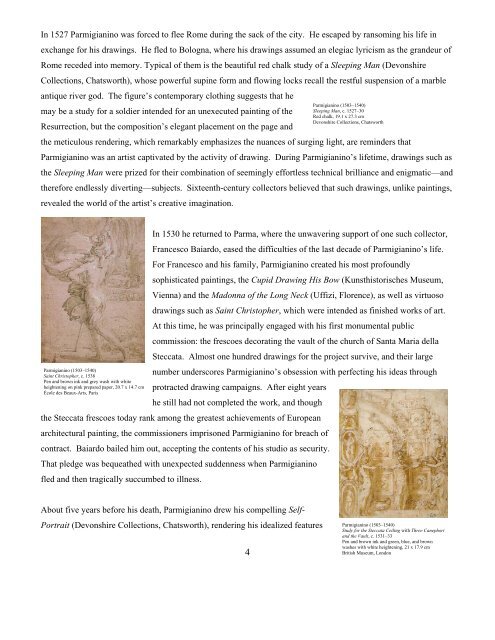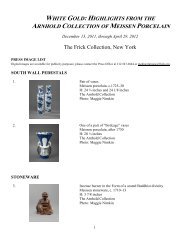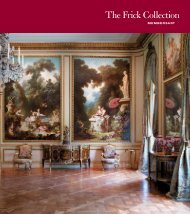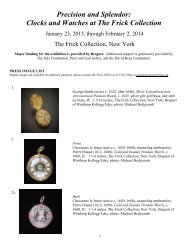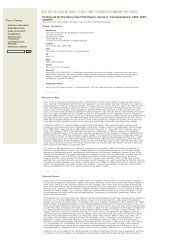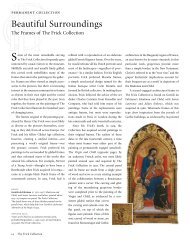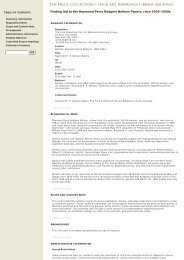ARCHIVED PRESS RELEASE THE FRICK COLLECTION
ARCHIVED PRESS RELEASE THE FRICK COLLECTION
ARCHIVED PRESS RELEASE THE FRICK COLLECTION
You also want an ePaper? Increase the reach of your titles
YUMPU automatically turns print PDFs into web optimized ePapers that Google loves.
In 1527 Parmigianino was forced to flee Rome during the sack of the city. He escaped by ransoming his life in<br />
exchange for his drawings. He fled to Bologna, where his drawings assumed an elegiac lyricism as the grandeur of<br />
Rome receded into memory. Typical of them is the beautiful red chalk study of a Sleeping Man (Devonshire<br />
Collections, Chatsworth), whose powerful supine form and flowing locks recall the restful suspension of a marble<br />
antique river god. The figure’s contemporary clothing suggests that he<br />
Parmigianino (1503–1540)<br />
may be a study for a soldier intended for an unexecuted painting of the Sleeping Man, c. 1527–30<br />
Red chalk, 19.1 x 27.3 cm<br />
Devonshire Collections, Chatsworth<br />
Resurrection, but the composition’s elegant placement on the page and<br />
the meticulous rendering, which remarkably emphasizes the nuances of surging light, are reminders that<br />
Parmigianino was an artist captivated by the activity of drawing. During Parmigianino’s lifetime, drawings such as<br />
the Sleeping Man were prized for their combination of seemingly effortless technical brilliance and enigmatic—and<br />
therefore endlessly diverting—subjects. Sixteenth-century collectors believed that such drawings, unlike paintings,<br />
revealed the world of the artist’s creative imagination.<br />
In 1530 he returned to Parma, where the unwavering support of one such collector,<br />
Francesco Baiardo, eased the difficulties of the last decade of Parmigianino’s life.<br />
For Francesco and his family, Parmigianino created his most profoundly<br />
sophisticated paintings, the Cupid Drawing His Bow (Kunsthistorisches Museum,<br />
Vienna) and the Madonna of the Long Neck (Uffizi, Florence), as well as virtuoso<br />
drawings such as Saint Christopher, which were intended as finished works of art.<br />
At this time, he was principally engaged with his first monumental public<br />
commission: the frescoes decorating the vault of the church of Santa Maria della<br />
Steccata. Almost one hundred drawings for the project survive, and their large<br />
Parmigianino (1503–1540)<br />
number underscores Parmigianino’s obsession with perfecting his ideas through<br />
Saint Christopher, c. 1538<br />
Pen and brown ink and grey wash with white<br />
heightening on pink prepared paper, 20.7 x 14.7 cm protracted drawing campaigns. After eight years<br />
École des Beaux-Arts, Paris<br />
he still had not completed the work, and though<br />
the Steccata frescoes today rank among the greatest achievements of European<br />
architectural painting, the commissioners imprisoned Parmigianino for breach of<br />
contract. Baiardo bailed him out, accepting the contents of his studio as security.<br />
That pledge was bequeathed with unexpected suddenness when Parmigianino<br />
fled and then tragically succumbed to illness.<br />
About five years before his death, Parmigianino drew his compelling Self-<br />
Portrait (Devonshire Collections, Chatsworth), rendering his idealized features<br />
4<br />
Parmigianino (1503–1540)<br />
Study for the Steccata Ceiling with Three Canephori<br />
and the Vault, c. 1531–33<br />
Pen and brown ink and green, blue, and brown<br />
washes with white heightening, 21 x 17.9 cm<br />
British Museum, London


